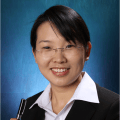KAUST was founded in 2009 and focuses exclusively on graduate education and research, using English as the official language of instruction. It offers programs in Biological and Environmental Science and Engineering; Computer, Electrical, and Mathematical Science and Engineering; and Physical Science and Engineering. It was announced in 2013 that KAUST had one of the fastest growing research and citation records in the world.HistoryKAUST officially opened on September 23, 2009, in Thuwal, Saudi Arabia.Campus[edit]Campus laboratories with town buildings and mosque on the leftResidential street with outdoor sculptureKAUST’s core campus, located on the Red Sea at Thuwal, is sited on more than 36 square kilometres (14 sq mi), encompassing a marine sanctuary and research facility.KAUST is the first mixed-gender university campus in Saudi Arabia. Saudi authorities hope the mixed-gender center will help modernize the kingdom's deeply conservative society. The religious police do not operate on-site. Women are allowed to mix freely with men and to drive on campus, and they are not required to wear veils in the coeducational classes.KAUST was Saudi Arabia's first LEED certified project and is the world's largest LEED Platinum campus.[7] Designed by international architecture firm HOK, it was also chosen by the American Institute of Architects (AIA) Committee on the Environment (COTE) as one of the 2010 Top Ten Green Projects.[8] The University Library received the 2011 AIA/ALA Library Building Award for accomplishments in library architecture. [9]LaboratoriesResearch institutions in the Kingdom and the region will link to the university’s supercomputer and other laboratory facilities through the 10 gigabits per second (Gbps) Saudi Arabian Advanced Research and Education Network (SAREN).[10]Supercomputer: Shaheen—the Arabian word for peregrine falcon—is the fastest supercomputer in the Middle East and one of the most powerful in the world. Developed by IBM, it is capable of 222 teraflops, or 222 trillion floating point operations per second. Shaheen was replaced by Shaheen II in 2015.Visualization: CORNEA is a fully immersive, six-sided virtual reality facility that gives students and researchers the ability to turn data into 3D structures that they can interact with and examine. It was built in partnership with the University of California, San Diego.Nanofabrication, Imaging, and Characterization: A clean-room environment equipped with tools to support research in advanced materials, biotechnology,electronics and photonics, and MEMS/NEMS. The Imaging and Characterization Labs include a suite of 10 nuclear magnetic resonance (NMR) spectrometers and facilities for scanning, transmission, confocal, and Raman Spectroscopy, magnetic and thermal measurements, allowing scientists to examine nanostructure devices and surfaces down to the level of individual atoms.Coastal and Marine Resources: Located next to the Red Sea, the Coastal and Marine Resources Lab facilitates marine research. The facility builds and deploys oceanographic instrumentation and provides operational services to support research vessels for marine exploration, diving, and sampling. Indoor and outdoor seawater facilities allow researchers to culture marine organisms.Analytical Core: These labs focus on spectroscopy, chromatography and mass spectrometry, trace metals analysis, wet chemistry, and surface analysis.Biosciences and Bioengineering: These facilities include genomic and proteomic labs essential to the study of cellular molecules for DNA sequencing and genetic analysis, as well as the investigation of cellular processes. The genomics facility is equipped with robots and laboratory automation.[10]Residential neighborhoodsKAUST students, faculty and staff live in one of three residential areas: Safaa Gardens, Harbor District and Safaa Island neighborhood. Areas of community activity include Discovery Square, multiple gym facilities, libraries, and coffee shops. Discovery Square includes a movie theater, a grocery store, and several restaurants.Academics and researchThe University organizes interdisciplinary collaborative research teams across three academic divisions Biological and Environmental Science and Engineering (BESE); Computer, Electrical, and Mathematical Science and Engineering (CEMSE); and Physical Science and Engineering (PSE). It offers two graduate programs: a Master of Science degree (18 months) and a Ph.D. program (3–4 years).[11]KAUST focuses on research that applies science and technology to problems of human need, social advancement, and economic development.[10] Four strategic research thrusts build KAUST’s research agenda: Resources, Energy and Environment; Biosciences and Bioengineering; Materials Science and Engineering; Applied Mathematics and Computational Science.[10]To support these thrusts, KAUST established multidisciplinary Research Centers focused on catalysis, clean combustion, computational bioscience, geometric modeling and scientific visualization, membranes, desert agriculture, Red Sea science and engineering, solar and alternative energy science and engineering, and water desalination and reuse.[10]Organization and administration[edit]This section is outdated. Please update this article to reflect recent events or newly available information. (May 2015)The first president of the university was Choon Fong Shih.[12] On February 16, 2013, the executive committee of the board of trustees at KAUST appointed Jean-Lou Chameau, the former president of the California Institute of Technology, as the new President of KAUST.[13]KAUST has established self-directed organizations. Its graduate student council was established in 2009, for voicing students' interests. Under the council there are four subcommittees: Academic and Research Committee, Graduate Life Committee, International Business Relations Committee and University Relations Committee.[14]Students[edit]As of September 2014, KAUST has 840 students in total. The student population comes from over 60 nationalities from all continents. The largest single national representation is from China with India in second place. Saudi Arabia is the third most prevalent nationality of the student make up.Building design information[edit]Size: 4 million square feet; 2.1 million square foot laboratory; 5.2 million square foot campusArchitect, Lab Planner, Lead MEP Engineer, Interiors: HOKArchitect of Record: Oger International, ParisMEP (Fire Protection): R.G. Vanderweil Engineers, BostonMEP (Energy Modeling): Affiliated Engineers Inc., SeattleStructural Engineer: HOK and Walter P. Moore, HoustonEnvironmental Consultant: RWDI, Guelph, Ontario, CanadaCivil Engineer: LJA Engineering, HoustonLandscape Architect: HOK Planning Group, AtlantaLighting Design and Consulting: HOK and Pivotal Lighting Design, Seattle











